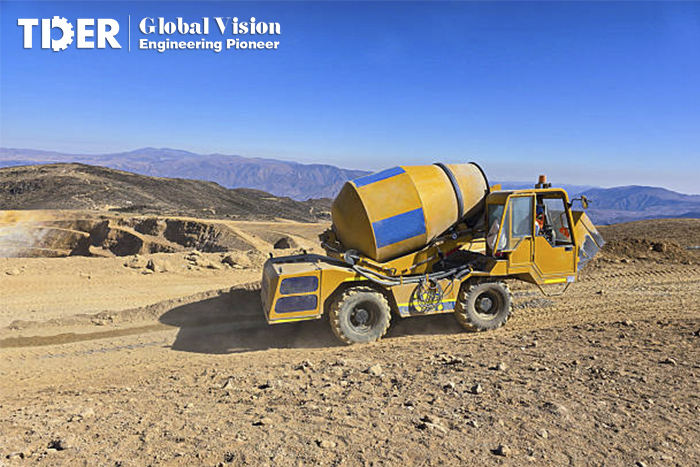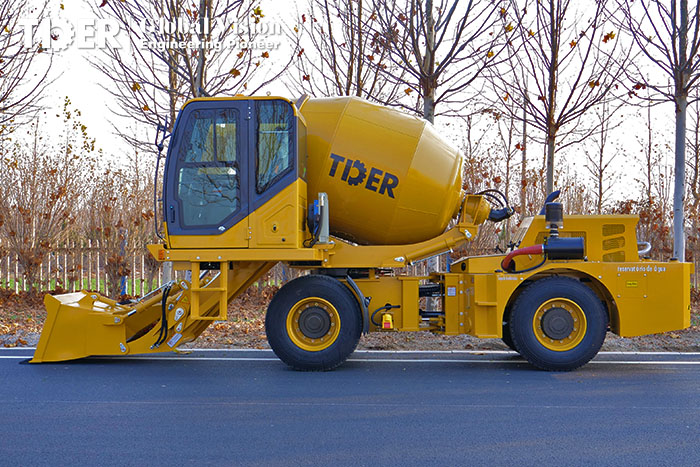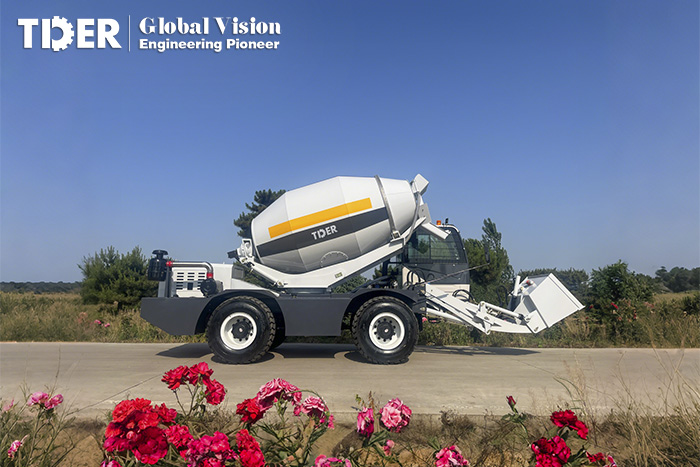Service Hotline:86-0592-5681408 / 86-17346269651
In construction projects, the mixing and transport of concrete are key steps for ensuring project quality. For a long time, ordinary concrete mixer trucks have handled the main tasks of transport and mixing, but they depend on external equipment for loading, which often limits efficiency. In recent years, Self - Loading concrete mixers have gradually entered the market. With the integrated advantages of being able to load, mix and transport, they are attracting increasing attention from contractors. So how does a Self - Loading concrete mixer work? What outstanding advantages does it have compared with traditional concrete transport trucks?

I. What Is a Self - Loading Concrete Mixer?
A Self - Loading Concrete Mixer Truck:(SLCM) is a multifunctional piece of engineering equipment that integrates loading, mixing, transport and discharging. Unlike ordinary concrete transport trucks, it has a loading bucket at the front end of the vehicle. This bucket can scoop materials directly from the stockpile and, via hydraulic control, feed aggregates, cement and water into the mixing drum, enabling automated operation. This integrated design means the Self - Loading mixer needs no additional loader or manual assistance. On small- and medium-sized projects, in remote mountainous areas or on job sites with limited access, it can independently complete the production and transport of concrete.
II. How Does a Self - Loading Concrete Mixer Work?
The greatest highlight of the Self - Loading concrete mixer design is that it organically integrates the four steps of loading, weighing, mixing and transport on one vehicle, forming an efficient, relatively self-contained mini concrete production system. The system not only has the transport function of a traditional concrete transport truck but also the ability to batch on site and mix in real time. This allows the job site to supply concrete quickly and precisely, reduces manual operations, improves construction efficiency and lowers material waste and costs. Its flexibility and automation mean it can work efficiently on cramped sites, fast-paced projects and even remote construction scenarios, significantly streamlining the process. Its operation can be roughly divided into four stages:
2.1 Automatic Loading
A bucket is mounted at the front of the vehicle. The driver simply manipulates the lever to load sand and aggregate into the mixing drum. The bucket can tip, eliminating the cumbersome step of secondary transfer with a loader in traditional operations. For example, when hardening rural roads, crews often pile the aggregate beside the road. The mixer can take materials directly without repeated shuttling.
2.2 Accurate Weighing and Water Control
To ensure accurate concrete proportions, the equipment can be fitted with a weighing system to measure sand and cement in real time. At the same time, the water supply system can automatically add water according to the set ratio. Compared with adding water by experience, the Self - Loading mixer greatly improves the uniformity of the mix. In actual applications, some small hydraulic projects use this function to avoid insufficient early strength caused by uneven water distribution.
2.3 Mixing Process
The mixing drum rotates under hydraulic drive, rapidly mixing aggregates, cement and water. The mixing time can be adjusted according to construction needs to ensure the workability and uniformity of the concrete. Unlike ordinary concrete transport trucks that depend on batching plants, the Self - Loading mixer can mix while traveling, reducing waiting time. In some urgent repair projects this approach can significantly speed up construction.
2.4 Discharging and Pouring
The mixed concrete can be discharged by reversing the drum. Some models are also equipped with a hydraulic telescopic chute that delivers the concrete directly to the pour point. In this way, at high-elevation foundations or sites with difficult terrain, operators no longer need to carry buckets and can quickly complete the pour, further improving efficiency.
III. Diversified Designs of Self - Loading Concrete Mixers
Self - Loading mixers not only integrate functions efficiently; their structural design and operating flexibility also show differentiated advantages. In terms of rotation modes, users can choose the suitable configuration according to their needs:
Drum-only rotation: The mixing drum rotates independently while the cab remains stationary. This provides stable operation and suits general working conditions.
Cab-and-drum rotation: The cab rotates together with the mixing drum, allowing the driver’s view to follow the discharge direction. This is particularly useful in narrow sites and complex operating environments and improves precision and safety.
For the vehicle structure, there are two main types:
Articulated models: These adopt a split front and rear design connected by an articulation, achieving a small turning radius and excellent manoeuvrability. They are ideal for confined spaces such as mountainous areas and village roads.
Integral models: These have an integrated body with a robust structure and high load-carrying capacity, making them more suitable for long-distance transport and large-volume project tasks.
This diversity of rotation modes and structural types enables Self-Loading mixers to flexibly adapt to a variety of construction scenarios—whether municipal patching, rural road hardening or bridge foundation pouring—matching different operational needs and improving efficiency and reliability.

TCM35A: TDER 3.5m³ Concrete Mixer Truck (Cabin and drum rotate synchronously)
IV. Advantages Compared with Ordinary Concrete Transport Trucks
The TDER Self - Loading concrete mixer excels over an ordinary concrete transport truck in capacity, discharge control, construction efficiency and on-site adaptability. Its capacity ranges from about 2.2–7.0 m³, with a maximum discharge volume of 1.5–5.5 m³, satisfying both small scattered jobs and continuous supply needs for municipal roads and bridge foundations. By contrast, ordinary concrete transport trucks generally have a fixed transport volume and only perform transport and mixing; they must rely on loaders or batching plants, leading to lower efficiency and dependence on road conditions and working space. This is particularly limiting in mountainous, rural or narrow site environments, where the difficulty and time costs are higher.
The biggest advantage of a Self - Loading mixer is that it integrates loading, mixing, transport and discharge in one machine, achieving multiple functions. A single driver can complete the operation independently, reducing labour input. Loading, mixing and transport proceed continuously, significantly improving efficiency. Equipped with a weighing system and water-control system, it can proportion materials precisely and ensure stable concrete quality, meeting the requirements of high-strength bridges and roads. It can also mix on site at any time, flexibly adapting to dispersed or small-batch tasks, avoiding premature setting problems, reducing process steps and improving the continuity of construction.
Whether for municipal pipeline repairs, rural road hardening or the continuous pouring of large projects, the Self - Loading mixer can quickly adjust its mode of operation to ensure smooth and efficient construction.

TCM40: TDER 4.0m³ Concrete Mixer Truck (Independent drum rotation)
Overall, through its continuous supply capability, diversified capacities and flexible operation, the Self - Loading mixer offers a high-efficiency, low-labour, stable-quality and widely adaptable solution. It not only optimizes the construction process but also effectively saves labour, materials and time costs, enhancing overall project benefits.
By integrating loading, mixing, water addition and discharge into the whole process, the Self - Loading concrete mixer solves the problems of low efficiency and high dependency in ordinary concrete transport trucks. It shows significant advantages, particularly in construction efficiency and the controllability of concrete quality. As job sites increasingly demand flexibility and refined management, Self - Loading mixers are being adopted in more and more engineering scenarios.
As a manufacturer with many years of experience in the industry, TDER not only offers a product range covering outputs from 1.5 to 5.5 m³, meeting diverse needs from small road hardening to water-conservancy and bridge projects; it also ensures that the equipment can meet multiple challenges in urban and rural construction, road engineering, water-conservancy projects and remote job sites through high availability, flexible operation, easy maintenance and quick return on investment. More importantly, TDER is not merely a mixer manufacturer but a one-stop construction machinery solutions provider. From mixers to loaders, forklifts and road machinery, TDER’s complete product range and comprehensive after-sales system help customers improve construction efficiency and optimise costs, continuously promoting the upgrading of industry construction methods.